Xerocomus Quél.
Recent molecular studies have shown that Xerocomus in its current circumscription is likely an artificial grouping and it is possible that it will be split at some point into smaller genera. Molecular studies also have changed our understanding about the species of xerocomoid boletes showing that morphological features are quite variable in this group. Not only microscopic study is essential for determination, but scanning electron microscope will be often needed in this “genus” as the spore ornamentation is not always seen under ordinary light microscope. Do bear in mind that macroscopic characters, such as colours, cracking cuticle, etc., tend to intergrade between the different species. Note that Boletus impolitus and Boletus depilatus that were shown to be close to Xerocomus subtomentosus and its allies, are here retained in Boletus for practical reasons. The same applies also for Phylloporus pelletieri, placed here in a genus of its own, but being also close to Xerocomus subtomentosus group.
Although large reference list will be found under most of the species, one should always consult Ladurner & Simonini (2003) having in mind that there are some new species (X. chrysonemus, X. marekii, X. silwoodensis) described after this otherwise superior book was printed. Useful keys, covering most of the European xerocomoid boletes (except some southern taxa) are provided by Knudsen & Vesterholt (2008), Hills (2008) and Kibby (2011), the later also featuring an excellent comparison chart.
Fruitbody medium to small sized, boletoid, without veil and ring. Stipe solid, often tapering towards the base. Flesh variously coloured, changing or not when exposed to air. Tubes not separable from each other, instead tearing apart. Pores usually angular.
Xerocomus communis (Bull.) Quél.
Description
Cap up to 10 cm, at first hemispherical, later convex to flattened, ochraceous, light to dark brown, olivaceous brown or reddish brown, dry, velvety or smooth, sometimes cracked. Stipe cylindrical, ventricose or club-shaped, yellowish and often with very fine red granules, often discolouring with age, blueing when bruised. Tubes pale yellow to yellow with olivaceous tint, blueing when injured. Pores concolorous with the tubes, blueing when bruised. Flesh whitish to yellowish in the cap, yellow in the stipe, with numerous orange, orange red or red dots in the stipe base, blueing slightly when exposed to air. Smell not distinctive. Taste not distinctive. Spores 11–15 × 4.5–6.5 μm, smooth. Pileipellis palisadoderm of septate hyphae of cylindrical, incrusted cells.
Habitat. Broadleaf or mixed woodlands, urban areas, mycorrhizal mostly with oaks (Quercus) or lime (Tilia).
Distribution. In Europe probably widespread, but the true distribution is yet unclear as it might have been confused in the past with Xerocomus rubellus.
Similarity. Most similar to Xerocomus rubellus with which it shares the presence of red dots in the flesh in the stipe base. The cap of Xerocomus communis is usually red coloured. Discoloured specimens of X. rubellus strongly resemble X. communis and the distinction is almost impossible. Compare also with Xerocomus bubalinus, which normally does not have red dots in the stipe base and has conspicuous pinkish tint in the flesh of the cap.
Note. Some authors apply different names to this fungus – Xerocomellus engelii, Xerocomus engelii, Xerocomus quercinus, Boletus declivitatum. Ladurner & Simonini (2003) include this entity in Xerocomus rubellus, while others (e.g. Watling & Hills 2005) argue it is a self-standing species. Until more definitive conclusion is reached I would rather threat it here as a species on its own. If it is considered a separate species the name Xerocomus communis will have to be abandoned at some point in favor of Xerocomus engelii or Xerocomelus engelii, depending on whether one recognizes Xerocomellus at generic level. The original description and the illustration of Xerocomus communis do not represent well the characters of the species in question as it was already noted by some authorities.
Photographs
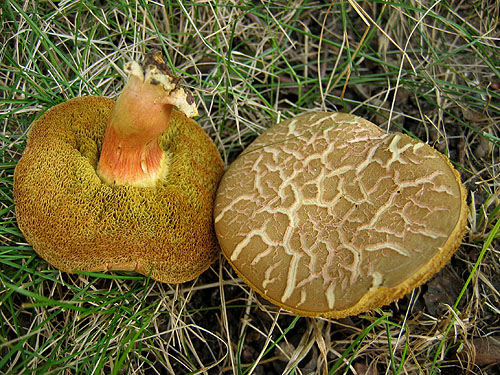
Fruitbodies of Xerocomus communis. (photo B. Assyov)
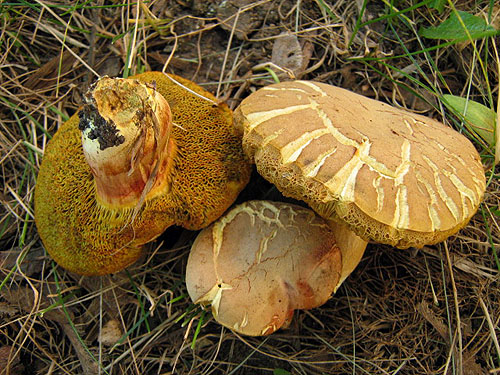
Another typical collection of Xerocomus communis. (photo B. Assyov)
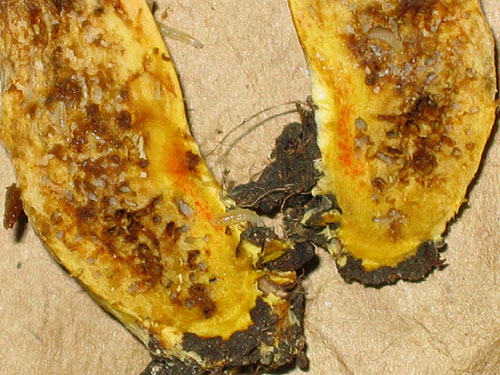
Xerocomus communis - red dots in the flesh in the stipe base. (photo B. Assyov)
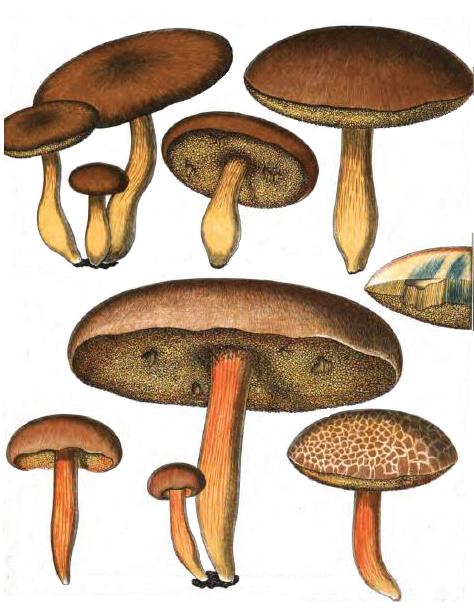
Bulliard's original drawing of Xerocomus communis published in his Herbier de la France. See the note above about the congruency of this painting with the current concept of this species.
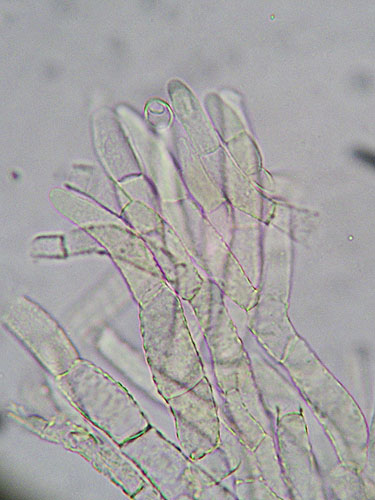
Cap cuticle of Xerocomus communis. (photo B. Assyov)
Important literature
Engel, H., Dermek, A., Klofac, W., Ludwig, E. & Brückner, T. 1996. Schmier – und Filzröhrlinge s. l. in Europa. Die Gattungen Boletellus, Boletinus, Phylloporus, Suillus, Xerocomus. Verlag Heinz Engel, Weidhausen b. Coburg.
Gelardi, M. 2009. First record of Xerocomus bubalinus in Italy and the generic placement of Xerocomus engelii comb. nov. – Bolletino dell’Associazione Micologica ed Ecologica Romana 75–76(3–1): 11–20.
Hills, A.E. 2008. The genus Xerocomus. A personal view, with a key to the British species. Field Mycology 9(3): 77–96.
Knudsen, H. & Vesterholt, J. [eds.]. 2008. Funga Nordica. Nordsvamp, Kopenhagen.
Ladurner, H. & Simonini, G. 2003. Xerocomus s.l. – In: Fungi Europaei. Vol. 8. Pp. 1–527. Edizioni Candusso, Alassio.
Šutara, J., Mikšík, M. & Janda, V. 2009. Hřibovité houby. Čeled’ Boletaceae a rody Gyrodon, Gyroporus, Boletinus a Suillus. Academia, Praha.
Watling, R. & Hills, A.E. 2005. Boletes and their allies (revised and enlarged edition). – In: Henderson, D.M., Orton, P.D. & Watling, R. [eds]. British Fungus Flora. Agarics and boleti. Vol. 1. Royal Botanic Garden, Edinburgh.